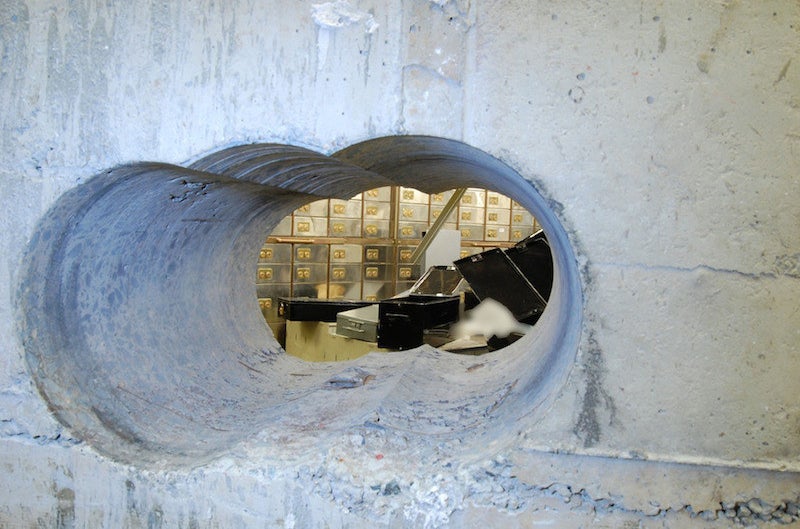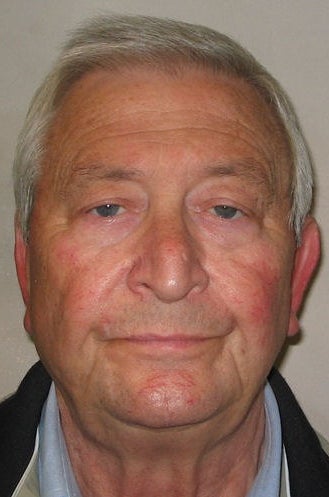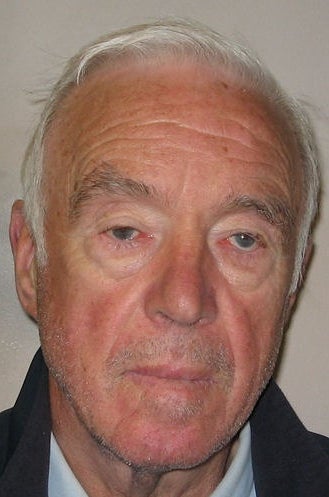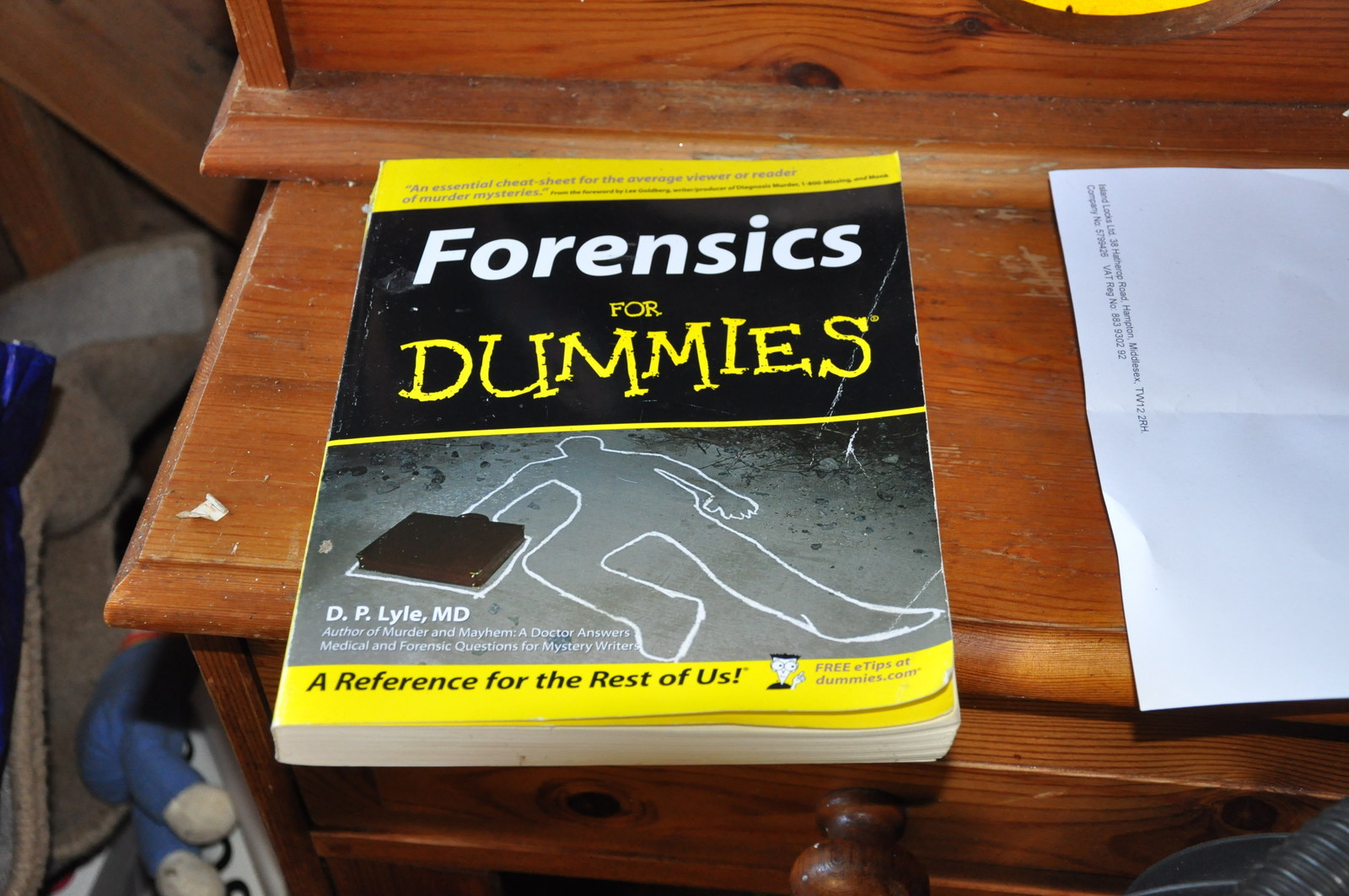It was described as a "professional" job, carried out in April 2015 by hardened career criminals with a clutch of convictions to their name. They got away with £14 million worth of jewels, gold, and cash from a secure vault without being spotted and left no trace of a break-in.
The thieves – who have a combined age of 442 – disabled a lift shaft to reach the vault in the basement, dismantled the building's alarm, forced open the iron gates leading to the vault, drilled through some 50cm of concrete, and clambered through a tiny 45cm-wide hole to finally get into the vault and rifle through the precious contents of 73 boxes at the Hatton Garden Safety Deposit Box Ltd.


The tunnel leading into the vault at the Hatton Garden Safe Deposit company, which was robbed over the 2015 Easter weekend.
The biggest burglary in English history was three years in the making and involved several reconnaissance missions – one of the gang actually entered the building in March 2015 and was later seen tampering with the lift on CCTV. Police believe it wasn't an inside job – it was simply expertly planned.
But three men were found guilty of their part in Hatton Garden jewel theft on Thursday, following guilty pleas from the four ringleaders last year, and the gang now await sentencing. With the oldest member aged 76, some of the men could live out the rest of their days in jail.
So, how did their meticulous plan fall apart?
The black Mercedes on Hatton Garden on Saturday 5 April.
The gang didn't use their mobile phones at the scene of the crime, knowing that SMS and phone call records could place them there, and used walkie-talkies instead.
But police didn't need phone records, because the gang went to and from the scene in a very unique car: a white E200 series Mercedes with a black roof and black alloy wheels. When looking through footage from 150 CCTV cameras after the raid, police noticed the car parked up near the Hatton Garden Safety Deposit business.
By running the numberplate through London's congestion charge database, they were led to the home of John "Kenny" Collins, 74, who acted as the gang's driver and pleaded guilty to plotting the burglary in October.
It appeared that the rest of the gang didn't think much of Collins' criminal ability, referring to him as a "wombat-thick cunt" who "lost the plot" in the weeks after the heist.
The Mercedes and another vehicle, owned by Terry Perkins, 67, who also admitted his part in the heist, were bugged by police soon after the raid, and officers were then able to listen in to the conversations of the conspirators.
According to a police transcript, Collins said on 15 May while travelling in Perkins' car: "The biggest cash robbery in history at the time and now the biggest tom [Cockney rhyming slang for jewellery, as in tomfoolery] in the fucking world, that's what they are saying ... and what a book you could write, fucking hell."



The police were now on the trail and able to watch the rest of the gang as they talked about what went wrong during the heist, discussed how and where they would divide the loot, and indulged in a good deal of matey banter.
The audio told the police that the heist had almost fallen apart due to dodgy equipment. Having gained access to the building on Friday 4 April, a jack and hydraulic ram the gang planned to use to knock over the securely fitted deposit boxes didn't work.
The following morning, Brian Reader, 76, despite being referred to "the Master" or "the Guv" by his co-conspirators, "bottled it", walking out and refusing to go through with the crime. Reader pleaded guilty for his role in the heist back in October.
But the rest of the team went to find new equipment (bought under the name "V. Jones" in reference to footballer turned screen gangster Vinnie Jones) and returned later that evening – still undetected – to carry out the heist.


A month after the heist, Reader, Perkins, and Collins met up in their regular haunt, the Castle pub in Islington, north London, to discuss the raid. It was here that the gang had planned the burglary during Friday night drinking sessions over the course of three years.
Footage shot by undercover officers at this meeting clearly shows Perkins demonstrating how he breached the vault wall with a diamond-tipped drill. Detective Constable Jamie Day referred to these recordings as tantamount to a confession.
Jones was heard to say: "It was hissing, that pump – BANG – didn’t it? That's all I could hear – BANG – and I thought, for fuck’s sake, I had a headache, Tel."
Brian Reader, Terry Perkins, and John Collins in the Castle pub, one month after the heist.
The heist was almost scuppered altogether when the gang members forced open a metal shutter before their mysterious red-wigged accomplice, known only as Basil, had disabled the alarms. A text message was sent to the business's owner and a security guard turned up – but he never entered the building and had no idea of the raid happening beneath his feet. The police were alerted but didn't go to Hatton Garden that day.
Basil is still at large and police have offered a £20,000 reward for information that leads to his arrest and conviction.

Police found a copy of Forensics for Dummies at the home of one of the gang, Daniel Jones, and police found no physical evidence inside the vault.
It's likely that the gang chose not to take weapons as the presence of them could have seen them charged with armed robbery, instead of burglary.
But ultimately, it wasn't the gang's actions inside the vault that caused their downfall, but their lax approach outside.
Reader, Perkins, and other members of the gang were famous career criminals in the '70s and '80s, and had done time for similarly audacious crimes. But in their heyday the Met didn't have access to 150 CCTV cameras watching the same street, or 230 automatic numberplate recognition cameras across London that monitor and record millions of cars coming in and out of London every year.
As Peter Spindler, the head of the Met's specialist crime investigations team at the time of the burglary, told The Guardian: "They were analogue criminals operating in a digital world. They lacked the knowledge to defeat digital detectives."
